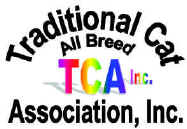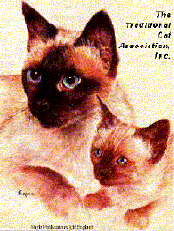
 The
Traditional Cat Association,
Inc.©1987®TM
Official Website
The
Traditional Cat Association,
Inc.©1987®TM
Official Website
Founded 1987, by Diana L.
Fineran
|
" Home of the Traditional Cat"© |
|
Our Motto: To Preserve,
Protect, Perpetuate, and Promote Traditional Cats.© |
|
|
||||
|
|
TRADITIONAL AMERICAN WIREHAIR©® FAQsHISTORY - PERSONALITY -
HEALTH HISTORY The Traditional American Wirehair is a natural, spontaneous mutation based from the Traditional American Shorthair that happened in the U.S.A. True to their origins the first Traditional Wirehair appeared in a litter born in a barn in Verona, New York in 1966. The parents, Fluffy and Bootsie, had no extra ordinary features. A spontaneous mutation is a “mistake” that happens during cell division, which happens very rarely. However, once a mutation occurs, the mutant genes can be passed from parent to child like any other gene. Moat mutations are recessive, meaning both parents must have the gene to reproduce it. In the case of the Traditional American Wirehair the gene is dominant, so only one parent needs to possess it to pass it along. Approximately 50 percent of the kittens in any given litter will be wire hairs if one parent has one copy of the dominant wire hair gene. They come in both short and long hair varieties. From the five kittens only two, a male and female, survived a weasel attack. The red tabby and white bicolor, male had a “strange” coat, so the farm owner, Nathan Mosher, asked the neighboring “cat lady”, Joan O’Shea, of nearby Vernon, NY. to look at this fascinating kitten. Joan decided the wrinkled coat deserved an attempt to reproduce it, so the tom, named, Council Rock Farm Adam of Hi-Fi, was mated with his litter sister. Kinked coated kittens were the surprising result! Since this litter was the result of inbreeding, outcross vigor was injected into the breed by going back to its origins. Adam was bred to a calico named, Tip-Toe, also obtained by Joan from the Mosher’s farm. A litter of two red and white Wire haired female kittens named Aby and Amy and two straight haired kittens were the result. All Adams kittens were bi-colors. Adam’s daughter, Aby, died very young, but Amy survived and went on to perpetuate the breed. Joan O’Shea sent samples of Adam’s hair to British geneticist, Roy Robinson for analysis. He determined Adam’s hair was unique and different from any of the Rex breeds. Joan sold Amy to Rex breeders, Bill and Madeline Beck, who sold Amy to Rosemonde Peltz, MD. Adam died of cystitis when he was only 4 years old. This caused Joan to discontinue working with the breed. Use of the Traditional American Shorthair contributed greatly to the breed and prevented further inbreeding, which is usually dangerous. The Traditional American Shorthair remains the only breed for out crossing and is crucial for the continued advancement of the breed. Interesting is the fact that subsequent mateings between Fluffy and Bootsie produced no additional Traditional American Wirehairs! Since their coat is of major importance, differentiating it from other breeds, and due to out crossing to a straight coated breed, there are many degrees of wire coats. Words such as; curly, frizzy, spiky, kinky, scruffy, crimped, hooked, bent, hard and dense are used to describe the coat appearance and texture. The coat can stand up in springy ringlets or coarse clumps. Each hair including the whiskers and the hair inside the ears looks crimped too. They have three types of hair, down, guard and awn, that are twisted or hooked. The parameters run from; completely covering the body with medium length, coarse, dense, crimped hair – to a very hard, sparse, quite thin coat that is completely wired – to anything in between. The hair in the hardest coats breaks easily. The feel of the coat is totally unexpected since it is fairly soft, but if it is dense and hard, it springs back when petted. The really hard coats feel prickly and not very pleasant to touch. Their coat lacks the shine that some breeds possess. Due to the large gene pool being used by out crossing to the Traditional American Shorthair it is possible for short haired parents to produce long haired kittens. If they are considerably wired, they are highly valued by pet owners, and make wonderful companions. Breeding has revealed this very unique coat is an incomplete dominant. That means even when breeding wire to wire, not all of the kittens will be wire haired. During the first part of the breed’s history all of the kittens produced were used in breeding programs to maintain the needed vigor. Many straight coated kittens resulted, but usually each litter had some of each. Any kitten with any wire in it’s coat any where was used to further the breeding program. PERSONALITY They are wonderful friends, people centered, gentle, sweet, affectionate, smart, playful, loving, agile and know no strangers. They are totally at ease with children. Like their Traditional American Shorthair forbears, they are not clingy. Instead they want to be near you or in your lap, but not in your arms. They relish their independence. Out going attitudes and clown like antics keep their people well entertained as well as them selves. HEALTH As a whole the Traditional American Wirehair is a hardy breed with few major health problems. It requires very little combing. Working with this breed can be a challenge due to the fact that some females have silent seasons. Due dates of litters are a ‘best guess’, if the breeder doesn’t witness the breeding when a male and female are together. Weather, stress or other various problems can cause a Traditional American Wirehair to drop or shed its coat, ending up looking much like a molting bird. Of concern is the coat makes the skin more sensitive to outside effects. A number of allergies have been found in some cats. To counter this, the skin should be kept thoroughly clean by regular bathing. Proper attention must be paid to the often greasy, oily skin, which some times creates the production of a great deal of dark ear wax that must be cleaned constantly. This factor is found in most of the Rex breeds. A preventative regimen is recommended to prevent the discomfort of a wired hair ball too!
|
|
The Traditional Cat Association, Inc.©1987®TM ALL RIGHTS RESERVED © by John & Diana Fineran - Aug 1999- 2025 No portion of this website or any information contained within it may be copied, or in any way distributed, without the expressed written permission of John or Diana Fineran - No exceptions. |